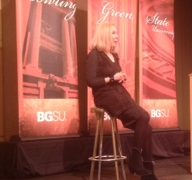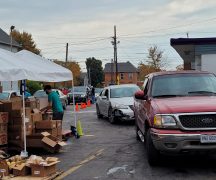Bowling Green State University is facing a $27 million budget short fall in the next fiscal year, according to a letter from President Rodney Rogers to the campus .
The university’s response to this is still evolving. “Because of the significance of this reduction, we are working to absorb this budget reduction over the next two fiscal years. We are looking for both short-term and temporary reductions as well as long-term and permanent budget reductions in FY21, but we will also need to consider further reductions in FY22 unless our planning forecast improves. The short-term and temporary reductions include a hiring freeze and operating budget reductions.”
The letter came a few hours after the Board of Trustees met and approved a policy covering furloughing employees.
“While we have not made a decision about instituting furloughs, this policy provides the University with the ability to achieve one-time and temporary budgetary savings through furloughs – unpaid employee leaves of absence from work for specified periods of time while retaining health and other benefits. Let me be clear, this would be just one small way to bridge the anticipated financial shortfall.”
Faculty, because they are unionized and covered by a collective bargaining unit, would not be furloughed, unless an agreement is negotiated.
The university is facing financial difficulties on several fronts.
Because of a decline in revenues because of the pandemic, the state is looking to cut funding for the rest of this year and next by 20 percent.
Also, the university gave credits and refunds to students for unused housing, dining and parking plans when classes moved online and students were told not to return to campus.
University officials also expect the effect the pandemic has on students and their family will result in a decline in the number of students attending BGSU. “we are modeling a variety of enrollment projections for next fiscal year,” Rogers said in the letter.
These budget cuts, he promised, will affect everyone, the education and general budget, which supports the academic mission as well as the auxiliary budgets, which support areas such as athletics, residence life and dining.
Because the academic mission “is our top priority” the initial budget reduction goals for academic units will be less, 8.5 percent than for administrative divisions, which will be 12.5 percent.
The trustees approved a measure that allows the furloughs to be distributed unequally over the education and general budget units on the Bowling Green campus; the education and general budget units on the Firelands campus; and the auxiliary budget units.
Below is the full text of Rogers’ letter.
The University continues to respond to the rapidly evolving COVID-19 situation. This semester has certainly changed in ways we could not have imagined just weeks ago. I want to again thank our faculty for their work in transitioning to an online teaching and learning model, our staff for their flexibility and productivity in supporting our students while working remotely, and those who have taken paid leave. This global pandemic has impacted all of us, and while we continue to prioritize the health and safety of our community, we are also working to position Bowling Green State University to be successful in a post-COVID-19 world.
We are facing unprecedented financial challenges. Ohio Gov. Mike DeWine has moved toward a 20 percent decrease in state funding. It is also important to understand that we have refunded and credited more than $11 million to our students for their unused housing, dining and parking plans. There are many uncertainties right now, including the impact that this pandemic may have on current and future BGSU students.
As of today, we are modeling a variety of enrollment projections for next fiscal year. These reductions in our resources will impact all areas of the University from our education and general budget, which supports our academic mission, to our auxiliary budgets, which support areas such as athletics, residence life and dining. Based upon our current assumptions, we a forecasting a nearly $27 million budget gap in the education and general budget on our Bowling Green campus and nearly $2 million at BGSU Firelands. As I mentioned in an earlier email, because of the size of this projected deficit and because this is an evolving situation, we are considering many, many options. I want to thank the hundreds of faculty and staff members who have also provided additional suggestions and ideas. The COVID-19 Financial Impact Ad Hoc Committee, comprised of administrators, faculty, staff and students, held its first meeting this week to begin to provide us feedback on these various ideas.
While an individual dean previously shared some information and his perspective of this issue with his college, I would like to make sure that you have a more complete understanding. Because of the significance of this reduction, we are working to absorb this budget reduction over the next two fiscal years. We are looking for both short-term and temporary reductions as well as long-term and permanent budget reductions in FY21, but we will also need to consider further reductions in FY22 unless our planning forecast improves. The short-term and temporary reductions include a hiring freeze and operating budget reductions.
As shared earlier, the academic mission of BGSU is our top priority, so our colleges have a smaller deficit percentage to address than other areas of the University. Our initial budget goal for colleges is an 8.5 percent reduction while other administrative divisions have an initial goal of 12.5 percent. We approach this next fiscal year on the cusp of global recession and we will need to operate with considerably less resources. Though this will be difficult, we believe we have found a path forward that does not compromise the educational experience or the quality of a BGSU degree.
Earlier today, the Board of Trustees met in a special meeting and approved several proposed action items including a furlough policy. This measure passed in a unanimous vote. While we have not made a decision about instituting furloughs, this policy provides the University with the ability to achieve one-time and temporary budgetary savings through furloughs – unpaid employee leaves of absence from work for specified periods of time while retaining health and other benefits. Let me be clear, this would be just one small way to bridge the anticipated financial shortfall.
The days ahead will be difficult. Before COVID-19, higher education was already in a period of great change. Now we must accelerate our focus on the future to meet this watershed moment. These financial strains are not representative of our hard work and progress, and we had no control of their impact on our community. I believe that we will overcome these unforeseen challenges, and when we are on the other side of this crisis, we will be an even stronger community and University. However, it will require us to think “anew and act anew.” As we work through this, please continue to share your ideas with us.
As president, the weight of these decisions, and the impact that they have on you, are not lost on me. I recognize that the uncertainly alone has made this process challenging. However, while difficult decisions must be made, we must support one another. COVID-19 has rocked our communities, but I am also struck how it has revealed the very fiber of who we are.
When our students cross the commencement stage and receive their degrees, it represents an education and a collective effort of each of our faculty and staff members. We are in this together. I remain committed to keeping you updated, and ensuring our University continues to prepare our students to be life-ready.





